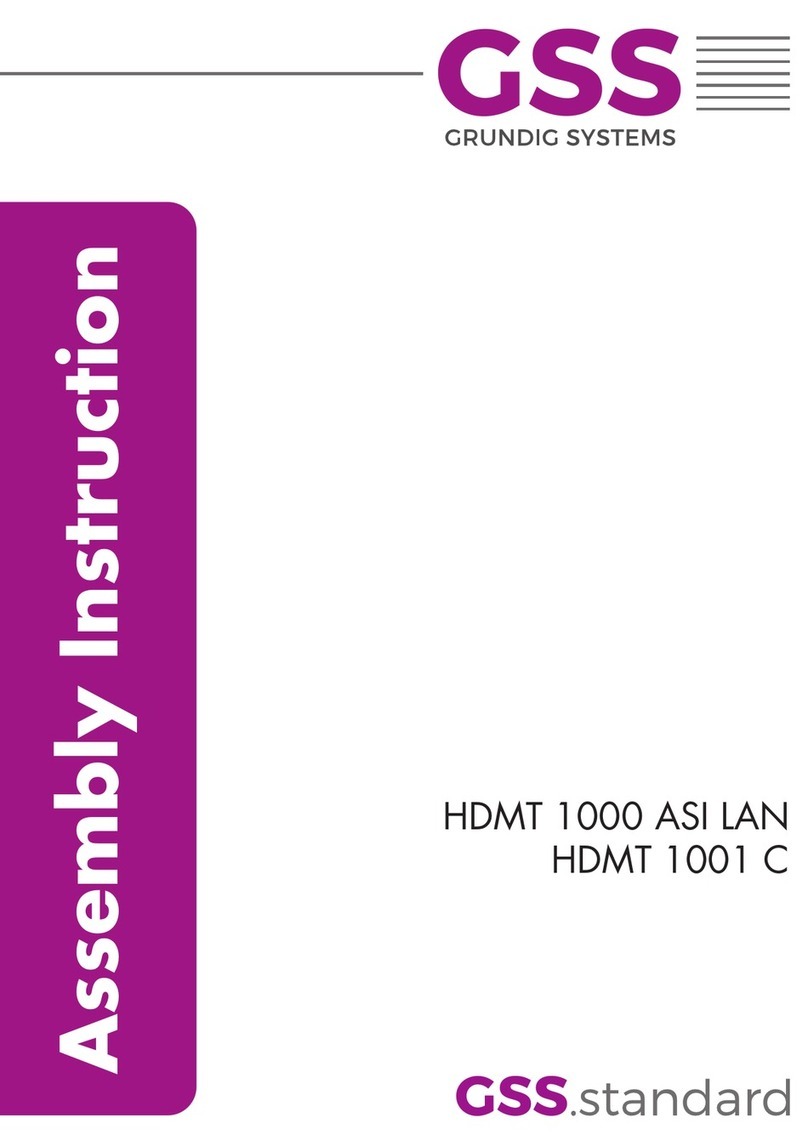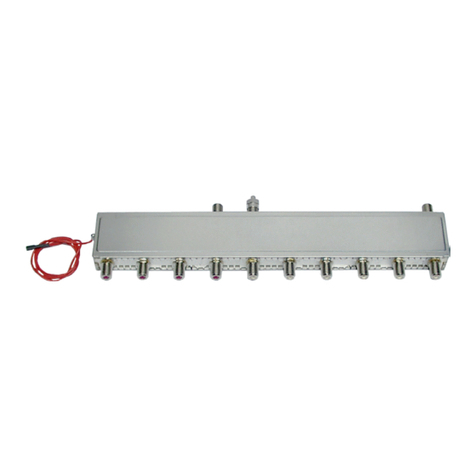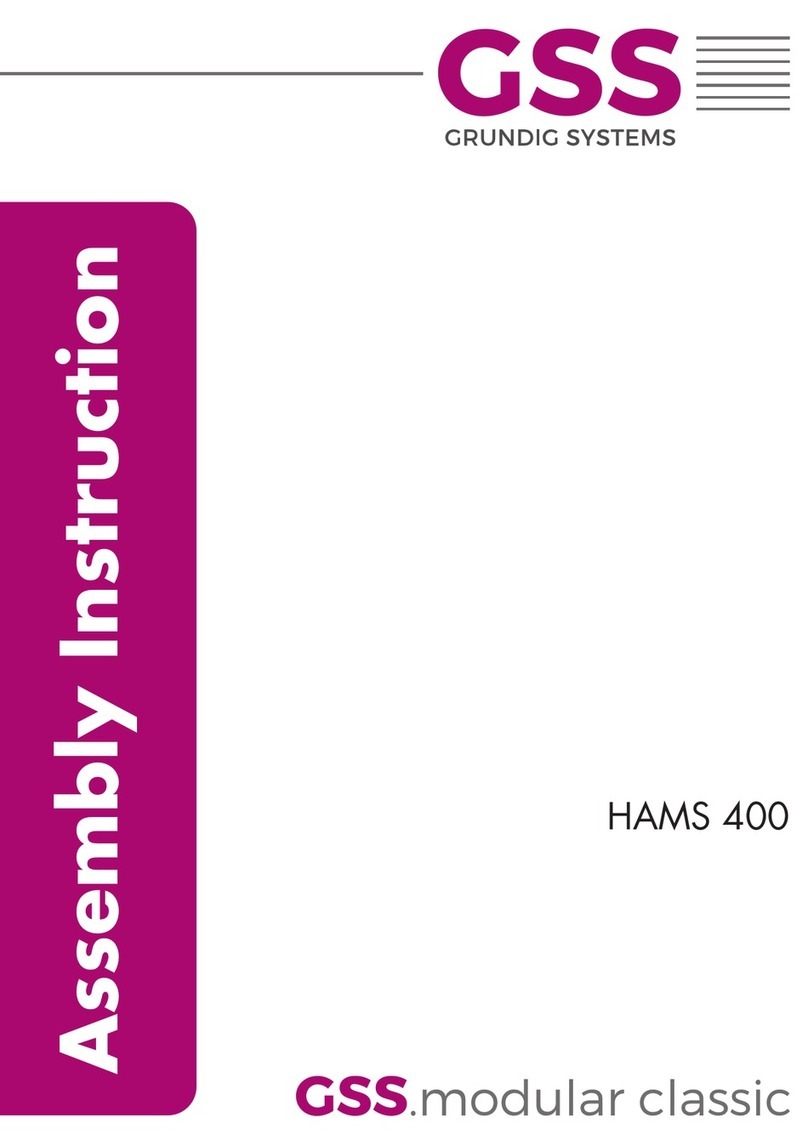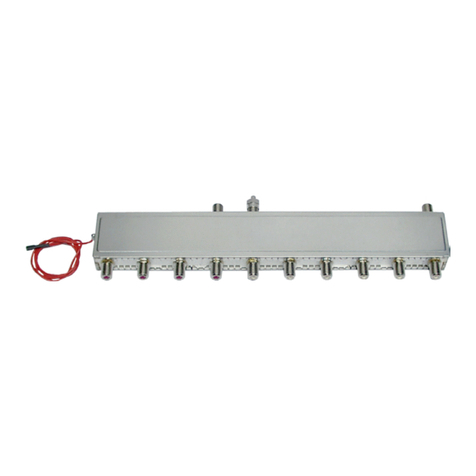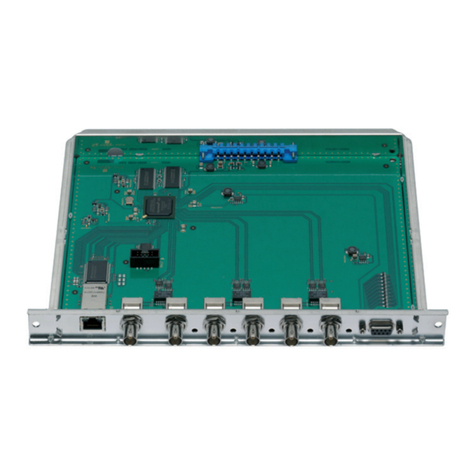Grundig GSS HRM 325 User manual

Assembly Instruction
HRM 325

- 2 - HRM 325
Contents
1 Safety regulations and notes ..............................................................................3
2 General information ..........................................................................................4
2.1 Scope of delivery ............................................................................... 4
2.2 Meaning of the symbols used ............................................................... 4
2.3 Technical specifications ....................................................................... 4
2.4 Description ........................................................................................ 5
3 Installation ........................................................................................................6
3.1 Installing the cassette .......................................................................... 6
3.2 EMC regulations ................................................................................ 7
3.3 Connecting the cassette ....................................................................... 7
4 Setting the cassette ............................................................................................8
5 Final procedures ................................................................................................9

- 3 - HRM 325
1 safety regulations and notes
• Assembly, installation and servicing should be carried out by authorised
electricians.
• Switch off the operating voltage of the system before beginning with assem-
bly or service work or pull out the mains plug.
• Do not perform installation and service work during thunderstorms.
• Install the system so it will not be able to vibrate…
- in a dust-free, dry environment
- in such a manner that it is protected from moisture, fumes, splashing wa-
ter and dampness
- somewhere protected from direct sunlight
- not within the immediate vicinity of heat sources
- in an ambient temperature of 0 °C to +50 °C. In case of the formation of
condensation wait until the system is completely dried.
• Ensure that the head-end station is adequately ventilated. Do not cover the
ventilation slots.
• Beware of short circuits
• No liability is accepted for any damage caused by faulty connections or
inappropriate handling.
• Observe the relevant standards, regulations and guidelines on the installa-
tion and operation of antenna systems.
• The standards IEC/EN/DIN EN 50083 resp. IEC/EN/DIN EN 60728 must
be observed.
• For further information please read the assembly instructions for the head-
end station used.
• Test the software versions of the head-end station and the cassette and
update them if necessary. The current software versions can be found at
"www.mygss.eu".
Take action to prevent static discharge when working on the device!
Electronic devices should never be disposed of in the household rubbish. In
accordance with directive 2002/96/EC of the European Parliament and the
European Council from January 27, 2003 which addresses old electronic and
electrical devices, such devices must be disposed of at a designated collection
facility. At the end of its service life, please take your device to one of these
public collection facilities for proper disposal.

- 4 - HRM 325
2 general information
2.1 sCope of delivery
1 HRM 325 cassette
1 Distance adapter set
2.2 meaning of the symbols used
Important note
—> General note
• Performing works
2.3 teChniCal speCifiCations
The requirements of the following EU directives are met:
2011/65/EU, 2014/30/EU, 2014/35/EU
The product fulfils the guidelines and standards for CE labelling.
RF input:
Input frequency range: .............................................. 87.5 … 108.0 MHz
RF-Output:
Output frequency range: ............................................ 87.5 … 108.0 MHz
Output level: ................................................................... max. 100 dBμV
Output impedance: ......................................................................... 75 Ω
Level adjustment: ....................................................................9 … 20 dB
Amplification: .................................................................. 43 dB ± 1.5 dB
Noise level: .............................................................................6 … 9 dB
Traps ...................................................................................................6
Tuning range:.................................................. 87.5 … 108.0 MHz
Attenuation: ...................................................................typ. 15 dB

- 5 - HRM 325
2.4 desCription
This cassette is for the reception of FM radio programmes. The signals within
the frequency range of 87.5 … 108 MHz are amplified by approx. 43 dB.
FM signals can be supplied to the cable network via the FM amplifier. This
involves sending the FM signals via an IEC socket to the FM amplifier. To
eliminate interference, up to 6 different input frequencies can be lowered with
tuneable traps. The amplified RF signals are supplied to the cable network via
the RF output of the FM amplifier and the RF output collector of the head-end
station.
The output level can be set at the RF output collector of the head-end station.
The software version of the control unit appears on the two-line LC display after
switching on the head-end station.
The cassette is designed for use in head-end stations of the standard line.

- 6 - HRM 325
3 installation
3.1 installing the Cassette
– Ensure the head-end station is mounted so it will not be able to vibrate.
Avoid, for example, mounting the head-end station onto a lift shaft or any
other wall or floor construction that vibrates in a similar way.
– Before installing or changing a cassette unplug the power cable from the
mains power socket.
• Remove the fastening screws 1 of an unoccupied slot from the bracket of
the head-end station.
• Insert the cassette in this slot and push it into the housing.
• Align the cassette and apply slight pressure to connect it to the connections
of the board and the RF bus bar.
• Fasten the cassette with the 1 screws.
1
1
+ + + + + + + +

- 7 - HRM 325
3.2 emC regul ations
To comply with the current EMC regulations, it is necessary to connect the lines
leading in and out of the head-end station using cable terminals.
When mounting the cassette in a head-end station which is installed in a 19"
cabinet, make sure the connections leading in and out for the 19" cabinet are
made using cable terminals.
CLASS
KLASSE
The attenuation of shielding of the connection lines must meet the requirements
for "Class A".
• Insert the required number of cable terminals in the openings provided in
the head-end station or in the 19
"
cabinet.
—> Cable terminals are not included in the scope of delivery.
Tighten the nuts of the cable terminals until the teeth on the lock washers
put un-
der
have penetrated the exterior coating and a good connection is made between
the housing
/ 19" cabinet
and cable terminals.
3.3 ConneCting the Cassette
• Connect the RF input cable to the ”RF input” of the cassette.
+
RF input

- 8 - HRM 325
4 setting the Cassette
In order to prevent interference, too high signal levels, e. g. of local transmit-
ters, can be reduced by absorption circuits.
• Switch on the head-end station.
Box 1 FM
87 – 108 MHz UKW
—> The display shows the following indica-
tion for the FM amplifier.
• Connect a spectrum analyser to the RF output of the head-end station.
• Set ”input level regulator” to the mechanical centre.
+
Traps
4 … 6
Traps
1 … 3
Input level
regulator
• If necessary tune the absorption circuit groups ”Traps 1 … 3” and
”Traps4…6” to the frequencies to be lowered.
—> You can lower 3 interfering frequencies each with the absorption cir-
cuit groups ”Traps 1 … 3” and ”Traps 4 … 6”. If the adjustment range
of an absorption circuit, for example from group ”Traps 1 … 3” is inad- is inad-
equate, you can lower the frequencies even further with an absorption
circuit that is tuned to the same frequency from group ”Traps 4 … 6”.
Example of the progression of the tunable acceptor circuits
0 db
-4 db
-8 db
-12 db
-16 db
8014015,195,78
-14 db
-17 db
in MHz
Frequency

- 9 - HRM 325
• When all of the signals are appropriately adjusted, use the ”input level
regulator” to increase the input level so that it is short of the intermodulation
intervention point.
5 final proCedures
After installing the head-end station, upgrading accessories or installing cas-
settes it is necessary to tighten all cable connections, cable terminals and
cover screws in order to maintain compliance with current EMC regulations
securely.
• Securely tighten the cable connections using an appropriate open-ended
spanner.
• Measure the output levels of the other cassettes and tune them to a uniform
output level using the appropriate level controls or software dependent on
the head-end station used. Please regard the assembly instructions of the
respective head-end station.
—>
In order to prevent interference within the head-end station and the
cable system, the output levels of the digital cassettes must be set
lower by 8dB compared to analogue cassettes.
• Mount the front cover (s. assembly instructions of the head-end station).

CE-Konformitätserklärung
GSS Grundig Systems GmbH • Beuthener Straße 43 • D-90471 Nuremberg
CLASSCLASS
KLASSEKLASSE
Phone: +49 (0) 911 / 703 8877 • Fax: +49 (0) 911 / 703 9210
www.gss.de/en • info@gss.de
Service: Phone: +49 (0) 911/703 2221; Fax: +49 (0) 911/703 2326; ser[email protected]
Alterations reserved. Technical data E. & O.E. © by GSS Grundig Systems GmbH 001/2017
Table of contents
Other Grundig Control Unit manuals
